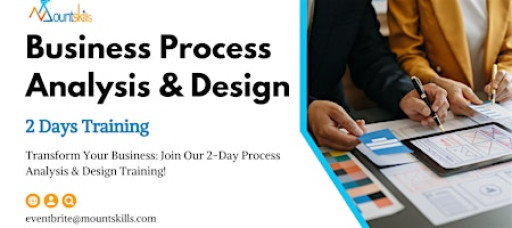

Certificate: Course Completion Certificate
Language: English
Duration: 2 Days
Credits: 16
Course Delivery: Classroom
Refreshments: Snacks, Beverages and Lunch included in a classroom session
Course Description:
This business process improvement course provides you with an opportunity to learn the essential knowledge and skills for applying the most effective and current business analysis techniques when modeling your business, comprehensively analyzing the current state, and subsequently designing the future state. The application of these techniques will be presented as part of an overall framework, as you identify key deliverables and the major steps from modeling and analysis of the current state and future state design.
Course Outline:
Develop the Process List
Every workplace contains business processes, however not all business processes are documented. This section focuses on how to develop a process list. After identifying the business processes, decision-making tools are practiced to consider what is important to the business. These tools include using prioritization and weighting criteria to make decisions based on business needs. Finally, you will discover how to gain support and buy-in from key stakeholders.
Define the Scope
Identifying the scope of the business process is critical for defining the boundaries of the project. In this section you will learn how to identify and document the boundaries of the business process that needs to be improved. Discussion and consideration of overcoming scope creep problems is also reviewed regarding the business process. Finally, you will determine what approvals are necessary before moving into a detailed business analysis.
Draw the Process Model
Process modeling ensures an understanding of the business processes being analyzed. In this section, you will learn the basics of process models, standard charting shapes, and the various levels used to draw business processes. Both visual models and text are practiced in this section to ensure an understanding of the current state, as well as review who needs to be involved in this step.
Estimate Time and Cost
Estimating time and cost for the current state involves analyzing process and cycle time, as well as existing costs to provide a return on investment. Examination of how to determine time and cost estimates for the current state is provided in this section, as well as the specific types of costs to analyze for potential business process improvement.
Validate the Process Model
Reviewing and confirming your analysis of the current state is critical before identifying potential improvements for the desired future state. This section focuses on the correct sequence to perform the validation steps with the project stakeholders. After validation is completed, improvement targets can begin to be identified.
Apply Improvement Methods
Now that the current state has been validated, the course focus begins to shift toward the future state. This section includes applying multiple techniques for proposing changes to the future state by using an extreme visual model. A process is followed to apply six improvement methods to ensure effective analysis work has been applied. Upon completion of analyzing what to improve, you will draw the process model for the proposed future state.
Establish Controls & Metrics
Adding controls to the business process ensures accuracy, reliability and can reduce errors. In this first part of the section, you will identify controls necessary for the future state. Establishing metrics helps ensure effectiveness, efficiency and adaptability of the business process. The second part of this section will help you distinguish which metrics will help evaluate whether the improved business process will work as you planned.
Test the Process
Testing the new or improved business process helps to identify bottlenecks, as well as work out bugs, defects and/or errors. Testing also helps ensure the process meets stated goals and provides for smooth implementation of the business process.
This section will help you identify what needs to be included in testing the proposed future state.
Evaluate Change Readiness
During the analysis process it is critical to consider what the business is trying to accomplish. Evaluating change readiness helps to create strategies for minimizing the change impacts on the workplace, the workers, as well as avoiding distractions.
This section examines change impacts, resistors to change and how to create an implementation plan for the changes identified to the business process.
Perform Continuous Improvement
Continuous improvement is an ongoing effort to enhance products, services or processes. This section focuses on how to monitor a business process and make adjustments as necessary so the business process repeatedly gets better over time.
You will learn how to use different root cause analysis techniques to improve business processes and how to put together a continuous improvement plan. Finally, you will monitor data to identify and rank performance problems once the business process has been piloted.
Hands-On Exercises
Target Audience:
Project Managers
Consultants & Analysts
Learning Objectives: